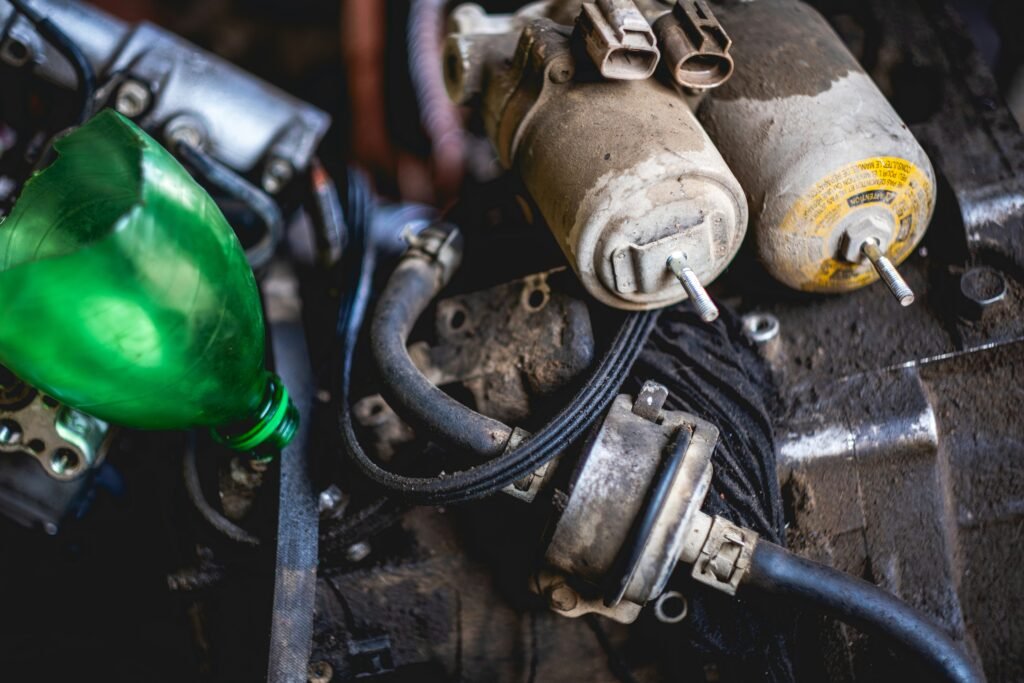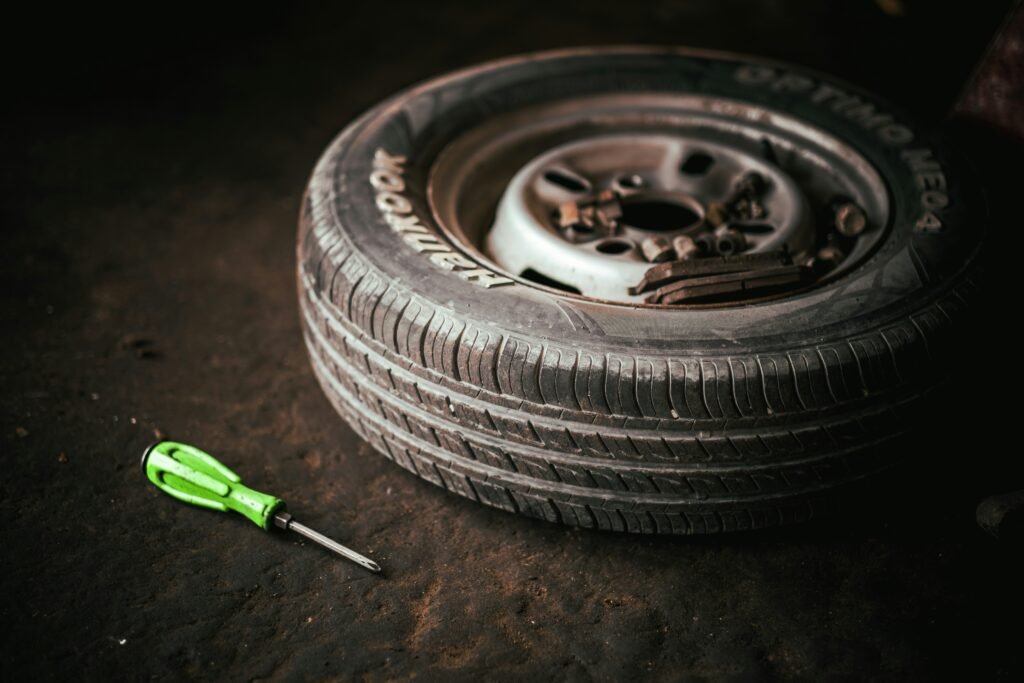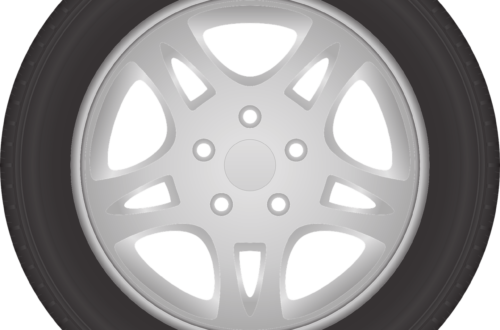You value your car and want to ensure it stays in the best condition possible. One crucial aspect of car maintenance is taking care of your tires. From regular inspections to proper inflation and rotation, there are several simple yet effective tips you can follow to minimize tire wear and tear. By paying attention to your tires and implementing these recommendations, you can extend the lifespan of your tires, improve fuel efficiency, and enhance your overall driving experience. So, let’s explore some easy-to-follow tips that will help keep your tires in great shape for miles to come.

This image is property of images.unsplash.com.
Maintaining Proper Tire Pressure
Regularly Check Tire Pressure
One of the most important aspects of maintaining your tires is regularly checking their pressure. Proper tire pressure is crucial for ensuring optimal performance, safety, and longevity. It is recommended to check your tire pressure at least once a month to ensure it is within the manufacturer’s recommended range. By doing so, you can detect any changes in pressure and address them before they cause any significant issues.
Inflate Tires to Recommended PSI
To maintain proper tire pressure, it’s essential to inflate your tires to the recommended PSI (pounds per square inch) indicated by the vehicle manufacturer. Different vehicles may require different PSI levels, so it’s crucial to refer to your owner’s manual or the sticker inside the driver’s door jamb for the accurate information. Underinflated tires can cause increased rolling resistance and excessive tire wear, while overinflated tires can lead to a harsher ride and reduced traction.
Avoid Overinflating or Underinflating Tires
It’s crucial to avoid both overinflating and underinflating your tires. Overinflating can result in reduced tire contact with the road, leading to uneven wear in the center of the tire. On the other hand, underinflating can cause the tire sidewalls to flex excessively, generating heat buildup and leading to accelerated wear on the tire’s shoulders. By maintaining the recommended tire pressure, you can ensure a smooth and comfortable ride while also maximizing the lifespan of your tires.
Rotating Tires
Follow Recommended Rotation Schedule
Rotating your tires is an essential maintenance practice that helps promote even tire wear and extend their lifespan. The recommended rotation schedule varies depending on the vehicle and tire type, but a common practice is rotating them every 5,000 to 7,000 miles. By following the recommended rotation schedule, you can evenly distribute the wear across all tires, ensuring consistent performance and prolonging their overall life.
Ensure Proper Wheel Alignment
Proper wheel alignment is crucial for both tire performance and longevity. When the wheels are not aligned correctly, it can result in uneven tire wear, reduced fuel efficiency, and compromised handling. Regular wheel alignment checks, typically performed by a professional, can help identify any misalignment issues and correct them promptly. Properly aligned wheels will not only optimize tire performance but also improve fuel efficiency and ensure a safe and smooth driving experience.
Inspect Tires for Uneven Wear
As part of the tire rotation process, it’s essential to inspect the tires for any signs of uneven wear. Uneven wear patterns can indicate alignment issues, suspension problems, or improper tire inflation. By identifying any uneven wear early on, you can take appropriate action, such as adjusting the tire pressure or addressing alignment issues, to prevent further damage and ensure the longevity of your tires.
Balancing Tires
Get Tires Balanced During Rotation
Tire balancing is a process that involves equalizing the weight distribution of the tire and wheel assembly. Getting your tires balanced during rotation is crucial for a smooth and comfortable ride, as unbalanced tires can cause vibrations and uneven tire wear. Balancing your tires ensures that the weight is evenly distributed, reducing strain on the suspension components and promoting optimal tire performance.
Check and Adjust Tire Balance as Needed
While tire balancing is typically done during rotation, it’s important to monitor the balance periodically to ensure it remains optimal. Over time, the balance of the tires can be affected by factors such as uneven wear, tire damage, or changes in the wheel weight. If you notice any vibrations or irregular tire wear, it’s important to have your tires checked and rebalanced if necessary. Properly balanced tires will not only enhance your driving experience but also extend the life of your tires.
Avoiding Overloading
Know the Maximum Load Capacity of Tires
Every tire has a maximum load capacity, which indicates the amount of weight it can safely support. It’s crucial to know the maximum load capacity of your tires and avoid exceeding it. Overloading your tires can lead to excessive heat buildup, increased tire wear, and even tire failure. Refer to your vehicle’s owner’s manual or consult the tire manufacturer’s recommendations to ensure you stay within the recommended load limits.
Avoid Exceeding the Load Rating
In addition to knowing the maximum load capacity, it’s important to be mindful of the load rating, also known as the load index specified on the sidewall of the tire. The load rating indicates the maximum weight that the tire can carry at its recommended pressure. Exceeding the load rating can result in compromised tire performance, decreased stability, and increased risk of tire failure. By distributing the load evenly and not overloading your vehicle, you can significantly reduce the wear and tear on your tires.
Distribute Cargo Evenly in the Vehicle
When carrying any significant amount of weight in your vehicle, it’s important to distribute the cargo evenly to prevent uneven tire loading. Uneven weight distribution can lead to imbalanced tire wear and compromised handling. Whenever possible, place the heaviest items in the center of the vehicle or distribute them evenly between the front and rear compartments. By maintaining proper weight distribution, you can minimize the strain on your tires and ensure their longevity.

This image is property of images.unsplash.com.
Driving Smoothly
Avoid Sudden Braking and Acceleration
Driving habits greatly impact the wear and tear on your tires. Avoid sudden and aggressive braking or acceleration, as these actions can cause excessive stress on the tires. Abrupt stops and starts can lead to tire scrubbing, where the tires skid slightly before regaining traction, resulting in accelerated wear. By driving smoothly and gradually accelerating and decelerating, you can minimize tire wear and promote safer driving conditions.
Take Turns and Curves Gradually
When navigating turns and curves, it’s important to do so gradually and smoothly. Sharp turns or excessive speed while turning can cause the tires to scrub against the road surface, leading to uneven wear. By taking turns and curves with care, you allow the tires to maintain better traction and minimize unnecessary stress. This promotes even tire wear and helps maintain optimal performance and vehicle stability.
Reduce Speed on Rough Roads
Rough roads, potholes, and uneven surfaces can pose a significant risk to your tires. To minimize tire wear and potential damage, it’s important to reduce your speed when driving on rough roads. Driving at higher speeds over potholes or uneven surfaces can cause the tires to impact the road with greater force, leading to sidewall damage or even tire punctures. By reducing your speed and driving cautiously, you can protect your tires from unnecessary wear and prevent costly repairs.
Avoiding Potholes and Obstacles
Watch Out for Potholes and Road Debris
Potholes and road debris can be a hazard to your tires. It’s crucial to keep an eye out for potholes and road debris while driving. Potholes can cause tire sidewall damage, misalignment, or even tire blowouts. Likewise, road debris such as broken glass, nails, or sharp objects can result in punctures or tire damage. By remaining vigilant and avoiding potholes and road debris whenever possible, you can prevent unnecessary tire wear and potential safety issues.
Slow Down and Maneuver Around Obstacles
If you encounter a pothole or road debris that you cannot avoid, it’s essential to slow down and maneuver around the obstacle as safely as possible. Reducing your speed will help minimize the impact on the tire and reduce the chances of damage. When maneuvering, try to position your vehicle in a way that avoids contact between the tire and the obstacle. By taking such precautions, you can protect your tires from significant wear and prevent the need for costly replacements.
Use Caution in Construction Zones
Construction zones often present challenging driving conditions, including uneven road surfaces, loose gravel, or debris. To protect your tires and maintain their longevity, exercise extra caution when driving through construction zones. Reduce your speed, watch for warning signs, and follow any instructions given by construction workers or road signs. By navigating construction zones safely, you can minimize the risk of tire damage and maintain optimal tire performance.

This image is property of images.unsplash.com.
Proper Tire Storage
Clean Tires Before Storage
If you need to store tires for an extended period, it’s important to clean them thoroughly before storage. Remove any dirt, debris, or brake dust from the tires using a soft brush and mild soapy water. This helps prevent contaminants from deteriorating the tire rubber during storage. Once cleaned, ensure the tires are completely dry before storing them to avoid moisture buildup.
Store in a Cool, Dry, and Clean Area
When storing tires, it’s crucial to choose the right location. Find a cool, dry, and clean area, away from direct sunlight, extreme temperatures, and humidity. Excessive heat or cold can affect the tire rubber, while moisture can lead to dry rot or other forms of tire deterioration. Consider using tire covers to protect them from dust and UV exposure if storing them for an extended period.
Avoid Excessive Weight on Stored Tires
When storing tires, it’s important to avoid stacking excessive weight on top of them. Prolonged pressure on a tire can cause it to develop flat spots, which can affect its overall performance once put back into use. If possible, store the tires vertically, hanging them on a tire rack or using a storage solution that allows them to rest without excessive pressure on the tread surface. This will help maintain the tire’s shape and integrity during storage.
Regular Tire Inspections
Check Tread Depth Regularly
Regularly inspecting the tread depth of your tires is crucial for safe and efficient driving. Inadequate tread depth reduces traction, especially in wet or snowy conditions, increasing the risk of accidents. Use a tread depth gauge or the built-in tread wear indicators to measure the depth of the tread grooves. Replace your tires when the tread depth reaches 2/32 of an inch to ensure optimal performance and safety.
Look for Signs of Uneven Wear
During regular tire inspections, pay close attention to any signs of uneven wear. Uneven wear patterns can indicate problems such as misalignment, improper tire inflation, or worn-out suspension components. If you notice any uneven wear on your tires, it’s essential to have them inspected by a professional and address the underlying issues promptly. By identifying and resolving the cause of uneven wear, you can prevent further damage and extend the life of your tires.
Inspect for Any Damage or Puncture
Inspecting your tires for any damage or punctures is essential for maintaining their safety and performance. Look for signs of cuts, bulges, cracks, or debris lodged in the tread. Damage or punctures can compromise the tire’s structural integrity, leading to potential failures and hazardous driving conditions. If you notice any signs of damage, have your tires inspected by a professional to determine if they can be repaired or need to be replaced.
Using the Right Tires
Choose the Appropriate Tire Type for Your Vehicle
Using the right tires for your vehicle is crucial for optimal performance and safety. Different vehicles require different tire types based on factors such as load capacity, traction needs, and weather conditions. Ensure that the tires you choose are compatible with your vehicle’s specifications and driving requirements. Consult the vehicle owner’s manual or seek advice from a tire professional to select the most suitable tires for your vehicle.
Consider Performance and Seasonal Factors
When choosing tires, consider both performance and seasonal factors. Performance-oriented tires are designed for enhanced handling and responsiveness, while all-season or winter tires provide better traction in challenging weather conditions. Assess your driving needs and the typical weather conditions in your area to determine which type of tires best suits your requirements. Using the appropriate tires for each season will optimize your vehicle’s performance and ensure your safety on the road.
Replace Worn-out Tires
Knowing when to replace your tires is crucial for maintaining safety and performance. Even with proper maintenance, tires wear down over time and lose their effectiveness. The tread depth, age, and condition of the tires should all be considered when deciding whether to replace them. Balding tires or tires with visible signs of damage should be replaced immediately, as they pose serious safety risks. Don’t delay replacing worn-out tires, as doing so will help prevent accidents and ensure your vehicle’s optimal performance.
Maintenance of Suspension System
Get Regular Suspension Check-ups
A well-maintained suspension system not only enhances comfort but also promotes tire longevity. Getting regular suspension check-ups is vital for identifying any issues with your vehicle’s suspension components. Issues such as worn-out shocks or struts can cause uneven tire wear and compromise tire performance. By having your suspension system inspected by a professional, you can address any potential problems early on and ensure the overall health of your tires.
Replace Worn-out Shocks or Struts
Worn-out shocks or struts can significantly impact tire wear and performance. These components play a crucial role in maintaining contact between the tires and the road, absorbing shocks and vibrations. When shocks or struts deteriorate, they can cause excessive bouncing or uneven weight distribution, leading to accelerated tire wear. If you notice any signs of worn-out shocks or struts, such as excessive bouncing or instability during driving, have them replaced promptly to ensure optimal tire performance.
Ensure Proper Wheel Alignment
Wheel alignment is not only essential for tire maintenance but also for the overall performance and safety of your vehicle. Wheels that are not properly aligned can cause uneven tire wear, compromised handling, and decreased fuel efficiency. Regular wheel alignment checks, performed by a qualified professional, can identify any misalignment issues and correct them. By ensuring proper wheel alignment, you can extend the life of your tires and enjoy a smoother and safer driving experience.
By following these tire maintenance tips, you can significantly minimize wear and tear on your tires, extend their lifespan, and ensure optimal performance and safety on the road. Regularly checking tire pressure, rotating tires, balancing them, avoiding overloading, driving smoothly, avoiding potholes, and properly storing tires are all essential practices for maintaining healthy tires. Additionally, conducting regular inspections, using the right tires, and maintaining the suspension system will further contribute to the longevity and performance of your tires. Remember, proper tire maintenance is not just about saving money, but also about driving with confidence and keeping yourself and others safe on the road.





